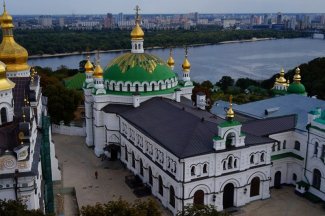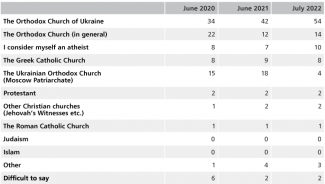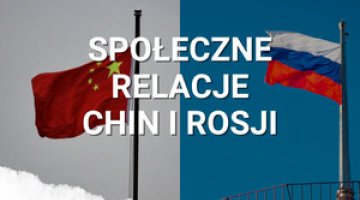Ukraine: a decisive blow to the Moscow Patriarchate?

29 March 2023 marked the deadline for representatives of the Ukrainian Orthodox Church of the Moscow Patriarchate (UOC-MP) to leave the Pechersk Lavra monastery complex in Kyiv, which they had been leasing. On 10 March the Ministry of Culture, which formally supervises the shrine, announced the termination of the agreement following a government audit which uncovered numerous irregularities there. Some of the clergy complied with the order, while another group headed by the lavra’s abbot, Metropolitan Pavlo (Lebid), refused. On 1 April, on the basis of a court ruling, the metropolitan was placed under house arrest for 60 days on charges of justifying the Russian attack on Ukraine. However, some monks still remain at the facility.
The decision to evict the UOC-MP from Ukraine’s most important Orthodox shrine is the culmination of a campaign which has been ongoing since last November. It has targeted the church which had served as a centre for the promotion of the so-called russkiy mir among the faithful for many years, while at the same time supporting the pro-Russian parties operating in Ukraine. The government’s tough measures have been bolstered by the fact that following the Russian invasion of Ukraine, this religious community, like other pro-Russian forces, has lost most of its former public support and has been beset with a crisis and internal rifts. The Ukrainian authorities, taking advantage of its weakening position and using their moral mandate resulting from the Russian aggression, have decided to deal the UOC-MP a blow in order to accelerate its marginalisation or absorption into the autocephalous Orthodox Church of Ukraine (OCU). In this way they are seeking to make the OCU the only ‘national’ Orthodox church in Ukraine.
30 years of the Moscow Patriarchate in the lavra
The Pechersk Lavra in Kyiv is one of Ukraine’s oldest Orthodox shrines and one of Europe’s biggest monastery complexes. It was established in the eleventh century and in 1994 it was put on the list of UNESCO World Heritage Sites. The complex is situated on a slope descending to the Dnieper. It consists of the upper lavra, which houses churches and museums (including the Dormition Cathedral), and the lower lavra which includes caves in which monks live, as well as churches, museums, a monastery, and the Kyiv Theological Academy and Seminary. Officially, the complex is supervised by the state: it is managed by the National Kyiv Pechersk Historical and Cultural Reserve which is supervised by the Ministry of Culture. However, for many years the Ukrainian authorities supervised the lavra in name alone: the facilities were operated by the UOC-MP, which in 1990 emerged from the Russian Orthodox Church (ROC) and acquired a high degree of autonomy. Nevertheless it remained under the ROC’s jurisdiction (the community refers to itself as the ‘Ukrainian Orthodox Church’, while the additional words ‘of the Moscow Patriarchate’ are widely used in Ukraine to highlight its links to the Russian Orthodox Church).
In 2013, during Viktor Yanukovych’s presidency, the UOC-MP signed a no-fee indefinite lease agreement with the government regarding the complex. For many years, the shrine was a bastion of Russian influence, for reasons including the openly pro-Russian views of its leaders, such as Metropolitan Pavlo, who is known for his penchant for luxury (which earned him the nickname ‘Pasha Mercedes’). The complex was visited on many occasions by Patriarch Kirill of Moscow, the head of the ROC, and by successive presidents of the Russian Federation. Following the first stage of Russia’s invasion of Ukraine in 2014, Metropolitan Pavlo accused Kyiv of initiating the aggression and called for unity with Russia. Similarly, he failed to condemn the Russian invasion after 24 February 2022. In November 2022, a video was published online showing a service in one of the lavra’s churches during which the attendees prayed for Russia; this sparked general outrage among the Ukrainian public.
The UOC-MP and the Russian invasion
Following the outbreak of the full-scale armed conflict, the UOC-MP assumed an ambivalent position towards it. Some of the clergy publicly supported the Ukrainian side and condemned the invaders, around 100 clergymen left the UOC-MP, and 15 dioceses (out of 53) across Ukraine severed their eucharistic links with the Russian Orthodox Church. Other clergymen (including Metropolitan Yelisey of Izyum, Metropolitan Iosif of Romny & Buryn, and Archbishop Arkady of Rovenky) supported the invaders. Following the de-occupation of these territories by the Armed Forces of Ukraine, they fled to Russia. In contrast, the highest-ranking hierarchs of the UOC-MP, who have had a decisive influence on the Church’s policy, adopted a wait-and-see attitude, failed to clearly distance themselves from Russia and preferred to watch the developments on the front. Alongside the amendments to the UOC-MP’s statute introduced in May 2022, which were intended to end its subordination to the ROC (the document was never made public), this attitude was widely interpreted as a mere sham. This was also how the moderate[1] condemnation of the aggression by Metropolitan Onufriy, the head of the UOC-MP, was interpreted. It was viewed as an attempt to protect the Church from public anger and state sanctions, rather than a genuine expression of support for Ukraine.
However, the invasion has provoked a radical shift in sentiment among the followers of the UOC-MP: the Church has lost the support of many of them, and its links with Russia are now considered unacceptable. In March 2022, most of the faithful were in favour of the Church severing its ties with Moscow (see Chart 1). In August 2022, a mere 4% of Ukrainians who consider themselves as Orthodox Christians identified themselves with the UOC-MP (see Table), and in December 2022 54% of the respondents supported a proposal to fully de-legalise this Church in Ukraine (see Chart 2).
Chart 1. What is your reaction to the UOC-MP severing its ties with the ROC?

Source: Оцінка ситуації в Україні, a Rating Group poll conducted on 8–9 March 2022, ratinggroup.ua.
Table. What religion do you identify yourself with? (proportion of answers in %)

Source: a poll conducted by the KIIS, 5 August 2022, kiis.com.ua.
Chart 2. What attitude should the Ukrainian government take towards the UOC-MP?

Source: a poll conducted by the KIIS, 29 December 2022, kiis.com.ua.
In formal terms, the UOC-MP continues to be the largest Orthodox church in Ukraine, although reports regarding the number of its members are inconsistent. The government’s statistics indicate that the Church has 11,400 parishes. Since the establishment of the OCU in December 2018, 1289 UOC-MP parishes have decided to join the former.[2] According to figures compiled by the OCU, at present it has more than 8000 parishes, while the UOC-MP has fewer than 8000, although it seems that the latter figure is overestimated.[3] There have been several waves of UOC-MP parishes joining the OCU. These were triggered by the establishment of the OCU and then by the beginning of the invasion (since 24 February 2022 at least 726 parishes have moved from the UOC-MP to the OCU). However, in subsequent months the trend has died down. At present, the transition process is being boosted by the developments regarding the Pechersk Lavra, such as the outrage sparked by the prayers for Russia held there, the Ukrainian government’s tough measures targeting the UOC-MP, and more recently by photos of a luxurious residence belonging to Metropolitan Pavlo, the lavra’s abbot. In recent weeks, the local government in several regions of Ukraine and the local parishes have taken similar steps regarding the churches occupied by the UOC-MP on their territory. The city councils of Khmelnytskyi, Rivne and Kamianets-Podilskiy have announced their intention to terminate the lease agreements for plots of land on which the church buildings are located. In Lviv, Khmelnytskyi, Rivne oblast and Ivano-Frankivsk, representatives of the parishes expressed their support for plans to join the OCU (in Ivano-Frankivsk the city authorities took over the church by force).
The government goes on the offensive
The Russian invasion has triggered a comprehensive de-Russification of Ukraine’s socio-political life, including a drive to eliminate pro-Russian forces such as political parties, oligarchs and the media from it. This process has also entailed religious communities, including the UOC-MP, which indoctrinated their members by promoting pro-Russian views over many years. The government’s attempts to marginalise this church is motivated by both reasons of state security (the desire to eliminate any institutions which spread Russian propaganda and host Russian agents) and political interest, as for many years the church activity supported political projects which competed with the plans of the president and his party. The government’s determination is growing along with the awareness that the pro-Russian forces have lost their almost entire social base as a result of the invasion, and that they no longer hold sway over people’s hearts and minds even in those regions and social groups among which they had been the dominant force.[4]
In November 2022, the state launched a large-scale counter-intelligence operation targeting the UOC-MP’s structures, involving the Security Service of Ukraine, the police and the National Guard of Ukraine.[5] During raids of numerous monasteries and other UOC-MP facilities, pro-Russian propaganda material was found alongside Russian passports issued to some of the top hierarchs, large amounts of cash, and other compromising material, including videos of child pornography. Around 60 criminal investigations have been opened against the church’s hierarchs, and some of the clerics have been covered by personal sanctions (these include the Kyiv Pechersk Lavra’s abbot Pavlo and the UOC-MP’s ‘sponsor’ and deacon Vadym Novynskyi, a billionaire and former member of parliament for the pro-Russian Party of Regions and the Opposition Bloc). In January 2023, the president issued a decree stripping several prominent UOC-MP hierarchs of Ukrainian citizenship. In April, investigative journalists revealed that Metropolitan Onufriy, the head of the UOC-MP, also held a Russian passport.[6] Three draft laws have been submitted to parliament to de-legalise the church, alongside a draft resolution to terminate the lease agreement pertaining to the Pochayiv Lavra – another major monastery in Volhynia region, operated by UOC-MP. Although none of these drafts has entered the legislative process, they represent an instrument of the cross-party pressure being put on the church.
The campaign culminated in the government terminating the lease agreements, first for the upper lavra (as of 1 January) and then the lower lavra (as of 29 March) in Kyiv. While the takeover of the former happened smoothly (the OCU was granted permission to conduct services there within a week, in the case of the latter, which mainly houses facilities occupied by the UOC-MP (the monastery, the Kyiv Theological Academy and Seminary), the process has encountered certain obstacles. Although several of the institutions which operated there have left the complex alongside some of the monks, Metropolitan Pavlo and a group of his supporters have refused to relocate. For several days he denied a government committee admittance to the lavra, which led to a court placing him under house arrest for two months. He is serving his house arrest in his formal place of residence, a luxury villa near Kyiv. Over the next week, the police began to summon individuals who had blocked access to the lavra’s facilities for interrogation on the basis of Article 179 of the criminal code (Illegal detention, desecration or destruction of religious shrines). By doing this, the authorities are hoping to break the resistance of the monks who decided to remain at the lavra, and to aggravate the rift in their ranks. The first sign of this rift was Archimandrite Avramiy’s decision to join the OCU. Immediately after this, Metropolitan Epiphany, the head of this church, appointed him acting abbot of the shrine.
It seems that the lavra’s takeover will be just a matter of time, because the recent developments have revealed that the UOC-MP has lost its potential for large-scale support from the public, the media and political figures in Ukraine. The groups of church members who blocked the lavra facilities alongside Metropolitan Pavlo, and held a rally following his arrest, were rather small.
Reactions from Russia and the Orthodox world
In their attempts to take over control of the shrine, the Ukrainian government is trying to avoid the use of force (such as removing the monks who remain there with assistance from the police). The authorities are trying to avoid fuelling domestic tensions and feeding Russian propaganda. The ROC and the Russian propaganda apparatus have for many years accused Ukraine of persecuting “the only canonical Orthodox Church in Ukraine” (which is how Moscow views the UOC-MP), the members of this Church and faith as such. Patriarch Kirill has said that “the Church’s persecutors are guided by the devil”, and some commentators went so far as to call for killing the Ukrainians (the head of the Radonezh Orthodox radio station Yevgeniy Nikiforov announced that Russia should burn all citizens of Ukraine alive in response to the developments at the lavra). From Moscow’s point of view, the Pechersk Lavra in Kyiv is important in the symbolic context because it is the cradle of the Orthodox faith and of the culture of ancient Rus’ (to which the Russian state views itself as having exclusive rights). For the Russian state, the ‘loss’ of this shrine will be another step towards Russian Orthodoxy losing control of Ukraine. However, neither the Russian Orthodox Church nor the Kremlin have any real instruments to influence the Ukrainian authorities’ actions towards the lavra or to halt the erosion of their religious and social influence in Ukraine. The Russian invasion has been the catalyst for this erosion. Driven by their sense of helplessness, they have attempted to publicise the ongoing dispute on the international stage: Russia’s foreign minister Sergei Lavrov has sent letters on the matter to the Secretaries General of the OSCE and the United Nations, and Patriarch Kirill has written to the ODIHR’s Chairperson-in-Office, the Secretary General of the Council of Europe, to Orthodox and Protestant churches, and to the Vatican.
In recent weeks, numerous autocephalous Orthodox Churches which support Russia, including the Polish, Serbian, American and Georgian Orthodox Churches and the Antiochian Orthodox Church, as well as the general secretary of the ecumenical World Council of Churches, have expressed concern about the developments regarding the shrine. Pope Francis has called on “both sides of the conflict” to respect places of religious worship.[7] The United Nations has also commented on the operation targeting the UOC-MP: in its report on the human rights situation in Ukraine it expressed concern that the raids carried out in the church’s facilities in November 2022 may have been discriminatory.
Although there have been no official expressions of support for Kyiv’s actions regarding the lavra, the lack of criticism from Western organisations and states can be interpreted as tacit approval on their part. Ecumenical Patriarch Bartholomew, who supports Kyiv, has not directly commented on the situation involving the shrine, although in March 2023 he accused the ROC of being jointly responsible for the war crimes Russia has perpetrated in Ukraine. This statement can be viewed as his tacit approval of the operation against the UOC-MP.
The state seeks to maintain its role as an arbiter
The government’s strike against the UOC-MP in the lavra has marked a turning point in the church’s operation in Ukraine, although the final takeover of the complex may take some time. It seems that the case of this shrine marks just the beginning of the operation to remove this church from the most important places of worship nationwide, and to achieve its full marginalisation or absorption by the autocephalous OCU. There have been reports that once the Kyiv Pechersk Lavra is taken over, the government intends to launch similar activities in the Pochayiv Lavra in Volhynia, which the UOC-MP has leased from the state free of charge since 2003 (the Viktor Yanukovych government signed the lease agreement for 49 years), and which is viewed as another stronghold of pro-Russian sentiment. Two criminal investigations were opened after raids there in November 2022, and the Ministry of Culture plans to audit the lavra’s facilities in a manner similar to the one carried out in Kyiv. In January 2023 the authorities of Ternopil oblast, which hosts the shrine, called on the ministry to terminate the lease agreement signed with the UOC-MP and to transfer the monastery to the OCU. On 28 March, the OCU’s synod established a parish on the premises of the Pochayiv Lavra.
The OCU and Metropolitan Epifaniy have made attempts to turn the weakening position of the UOC-MP to their advantage. Since its creation in 2018, the OCU has expressed its ambition to rule the hearts and minds of all Ukrainian Orthodox Christians, and has presented itself as the only canonical Orthodox Church in Ukraine. At the same time, it views the UOC-MP as an organisational unit of the ROC whose canonical status in Ukraine is unclear. It has sought to absorb the UOC-MP’s parishes and representatives, a process which was politically supported by the then president Petro Poroshenko. The OCU has become actively involved in the dispute over the Kyiv Pechersk Lavra, and has held talks with both the government’s representatives (regarding efforts to take over the complex) and ordinary monks. In March 2023, Metropolitan Epifaniy issued an appeal to these monks, in which he assured them that the monastery would not be closed down and called on them to unite under the auspices of the OCU. He also promised that those monks who decided to join the OCU would be allowed to remain at the lavra, and that the Old Church Slavonic language would continue to be used (alongside Ukrainian) during services.
There is a synergy between the actions of the government and the OCU: their common goal is to marginalise the UOC-MP, which remains the biggest church in Ukraine. It should be noted that the Ukrainian state is seeking to maintain its role as the principal actor, both as regards the future of the Moscow Patriarchate and in issues relating to the historic buildings linked to the Orthodox Church and the rules for their utilisation by the OCU. In the most likely scenario, one-off permits to conduct services in the churches of the upper lavra will be issued (the OCU has already conducted several services there, each time on the basis of a relevant permit), and a lease agreement with the OCU regarding the facilities of the lower lavra will be signed; this time the agreement will have a definite term and will specify a lease fee. The historic Saint Sophia Cathedral in Kyiv, which has the status of a museum, operates on the basis of a similar lease agreement. The state issues one-off permits for services to be held there (in 2019 Metropolitan Epifaniy’s enthronement was celebrated in the cathedral), and the OCU has signed a lease agreement for the smaller church (the so-called ‘warm Sophia’) in which services are conducted on a regular basis.
It seems that in their attempts to bring about a final resolution to the issue of the UOC-MP’s presence in Ukraine, the president and his aides are continuing Petro Poroshenko’s plan to create a ‘national church of Ukraine’. Although initially Zelensky was rather indifferent to matters relating to religion, in the context of the invasion and the Ukrainian public’s expectations regarding the elimination of Russian influence, he has seized the political opportunity to act as the ‘vanquisher of the hostile religious centre’ and the advocate of a patriotic church, and thus to make Ukraine independent of Russia in religious terms also.[8] Although the authorities view the OCU as an ally and a beneficiary of the operation intended to ‘eliminate’ the UOC-MP, they will seek to keep hold of the instruments which have enabled them to retain control of the realm of religion, that is, to ration access to Ukraine’s main shrines which have the status of museums and monuments of architecture, to supervise the funds available for the renovation of churches, and so on. It is likely that in exchange for boosting the status of the OCU and increasing its presence in the main centres of religious worship, the government may expect the Church’s leaders to show loyalty to the state, which will help it to consolidate its political support in the future.
[1] ‘Звернення Блаженнішого Митрополита Київського і всієї України Онуфрія до вірних та до громадян України’, Українська Православна Церква, 24 February 2022, news.church.ua.
[2] See Урядовий Кур’єр – видання Кабінету Міністрів України, ukurier.gov.ua.
[3] See С. Кошкіна, ‘Митрополит Епіфаній: «Ми просто терпимо присутність МП – вони не мають права перебувати на нашій території»’, LB.ua, 6 January 2023, lb.ua. See also T. Olszański, ‘The fight for canonical independence for Ukrainian Orthodoxy’, OSW Commentary, no. 272, 11 June 2018, osw.waw.pl.
[4] See J. Rogoża, ‘New Ukraine: a breakthrough at great cost’, OSW Commentary, no. 492, 22 February 2023, osw.waw.pl.
[5] See J. Rogoża, P. Żochowski, ‘Kyiv versus the Orthodox Church of the Moscow Patriarchate’, OSW, 1 December 2022, osw.waw.pl.
[6] See М. Ткач, ‘"Гражданін" Онуфрій. "Українська правда" публікує російські паспорти священнослужителів УПЦ’, Українська правда, 7 April 2023, pravda.com.ua.
[7] Some commentators argue that in his views on Ukraine, including his repeated appeals to “both sides of the conflict”, the Pope may to some degree have been influenced by Leonid Sevastianov, the President of the World Council of Russian Old Believers, who has maintained close contacts with the Pope for 10 years. It was reportedly Sevastianov’s idea that Pope Francis should act as a mediator between Zelensky and Putin.
[8] Zelensky’s increased interest in religion is corroborated by the change of the head of the State Service for Ethnic Policy and Freedom of Conscience (in December 2022 the prominent religious scholar Viktor Yelensky was appointed to this post), and by the decision to increase the service’s role in the Ukrainian government (it is now supervised directly by the prime minister).




